Before beginning with splits it is important to remember that you want good genetics and a queen that has been raised well. You do not want a queen-less nuc that is forced to make an emergency queen.
1. Never do this when weather or nature can bite you in the behind. Nothing worse than losing valuable brood and nurse bees to an unexpected frost.
2. Always have queen bees ordered and waiting to fill that split, or utilize your own existing ripe queen cells ready to emerge.
3. Always try to get a good local (native) queen, or queens that will improve your own apiaries genetics like NWC. (New World Carniolan) or other proven ‘Survivor stock’ queens.
4. If the pollen and nectar flow is with you and you find a ripe queen cell ready to emerge. Make use of her.
5. Never create or keep nucs that have been filled with an emergency raised queen. Kill her off and introduce a good queen.
6. Open up the target hive and check that the one to be split has a healthy number of bees. Also do not begin this until you know that drone activity has begun in your apiary.
7.Leave the splits queen less overnight before introducing the mated queen. Come back the next day and put in mated queens or a cell. Preferably in the late afternoon.
Remember that all these nuc splits are temporary housing until you can buy in and introduce good queens. They are queen less and have eggs or very young larvae and they will attempt to make an emergency queen.
When bees raise a new queen by emergency queen rearing behavior, you will get inferior queens. “They pick out several larvae to start raising into queens, not always the youngest possible, and the queen you end up may not have been fed a royal jelly diet as intensively as she could have.” This results in slightly smaller queens at emergence and their performance will affect your hive for years.
Most people move the new nuc boxes to a new location and being mostly nurse bees that is fine. If you got greedy and attempt a two or three nuc spot. You may want to leave the NUC in the original spot and move the mother hive to another property or at least 100 feet away. This will allow foraging bees from the mother hive to augment the new hive, further augmenting their survival situation.
Not doing so, will mean that foraging bees from the nuc boxes will return to the original hive location. That is okay, if you have enough brood and nurse bees… but you will lose bees this way. The best alternative is to move these nucs elsewhere and the foragers will y return to the new nucs as they will reorient to a new location. If it far enough away.
There are many different methods to make splits, either from double double brood chambers or a strong single brood one.
Some involve finding the queen bee. others do not.
1. The most simple one. Doing so without even finding the queen.
Using your existing overwintered hive. This may be a single or double brood chamber.
If later in the summer, remove any honey supers. Remove the excluder and check that larvae and pupa are being made. Always check the health of the hive. You WANT a lot of active working bees!!!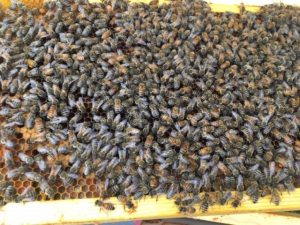
Needed. Another hive box to provide replacement frames and foundation to those you will remove. These will be last years extractions and or combs from a hive that may not have overwintered.
Frames that have some honey will be great to add. Remove four frames from the nuc to be made. SET aside.
You will need a queen excluder and a smoker, especially if the hive is not a tranquil one. Doing this on a sunny warm day helps greatly. Clouds, rain or wind not so.
Smoke lightly and look for a few brood frames to move into the starter splits. (This can be a single super, two four frames or even into three frame nucs. For now we will just assume a regular 10 frame box.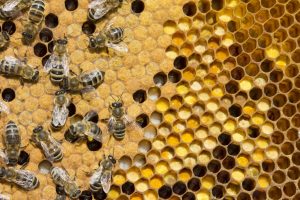
Brood, with pollen will be needed. Eggs, larvae and capped brood should be showing on both sides of the frames to be transferred.
So examined, and making sure you miss the queen bee – you shake the bees off – back into the hive. (You really want to avoid shaking a queen bee off… so make sure she is not on those frames. Brushing off can also be done.
Set that frame into the new box. Look for the next. No queen, but lots of brood. GREAT. place next to the other frame. Now, you can add another frame that has more pollen to feed the nuc. We are looking for THREE to four such frames depending upon the size of the nuc box you use.
To review, from the brood super (single or top one)… you have shaken the bees back into the hive and put three to four brood frames into the new nuc and one with honey
You replace the removed frames in the brood super with what you have available from last year. Extracted frames are great. Then put the queen excluder in place. Set the nuc box above the queen excluder and put the honey supers if you have any back on.
This nuc combination will not have a queen nor are there many bees in the upper nuc box, but by leaving them on the box, nurse bees will migrate up to take care of that brood and so can later be removed.
Leave the nuc box on for a day or two and come back in the late afternoon and remove the top honey boxes (if any). Place the nuc on a new bottom board and cover.
MOVE to a new location and the next day introduce a new queen.
Remember you KNOW that the queen is still in that original box, so we come back in a week to see if another brood chamber is needed. Add a queen excluder at that point.
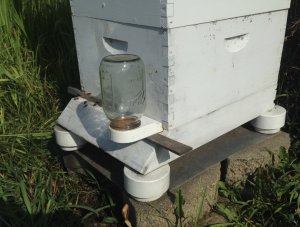
Splitting a DOUBLE brood chamber hive that does not require finding the queen.
It will however need you to be able to check egg cells as well as larval brood. To do this you will need a queen excluder and a two frame hive.
First day. Open it up, crack the two hives apart and smoke between, then insert a queen excluder between the two.
It is a good idea to put a piece of plastic down or a sheet of plywood on which you can lay some round PVC or bamboo. Put the second hive box on that while you put the excluder between. Or better yet have a friend assist!!!
This restricts the queen from moving between boxes and after waiting FOUR DAYS you open it up and check the first box for eggs. Smoke again.Set the upper box on an up sided cover lid and examine.
The queen excluder remains on the lower box. Reason being, if the queen was laying in BOTH boxes, the eggs would have turned into larvae by then.
IF you do not find any eggs in that upper box you now go into the bottom box. BTW when checking for the queen always double check the queen excluder first before laying it aside.
You check the brood frames looking for empty spaces around the caped brood. this is were the eggs will be found.
Now if the first hive box had larva and eggs we can simply set that one aside to start a new nuc. You introduce a new queen as soon as you can!!!!
If your first box does not have enough new egg cells and young larvae you can pull one or two out of the queened lower box and replace frames.
The third method involves two brood chambers and searching out the queen.
On a strong hive colony you begin by taking the honey supers off and going down to the lower two brood chambers.
Smoke and remove the queen excluder.
In this method one searches, finds the queen and cages her. This queen will be set aside and she will be put back into the original hive and the split will get the new queen as it will be the weaker colony and is more likely to accept a new queen than a stronger established colony.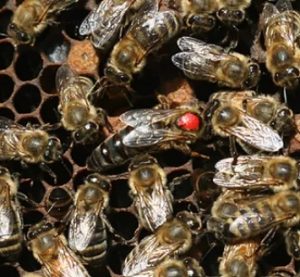
Brood frames should be examined and if queen less set aside. The queen, if found can be caged or carefully put, frame and all into a new brood box.
That new brood box should be ready to go with a bottom board already attached. This is full of frames and we remove all but two foundation frames on each side. In the center we will want to place brood frames. Three to four capped brood frames will be needed. Extra space is left to the side so we can shake THREE more brood frames of bees into this split.
In the original hive you replace the frames with older drawn comb or even honey bearing frames. In the split you move the three brood combs to the center and put some honey or pollen filled comb next to them.
Smoke, inner cover and top. This needs to be moved to a new location – preferably elsewhere so foraging bees do not return to the original hive.
This will need to have a queen introduced – preferable the next day. Leave alone for a week. The caged queen or the frame containing the queen is put back into the original hive.
If you have a super duper hive with two good brood chambers this is method #4
You will need TWO queen excluders for this method. 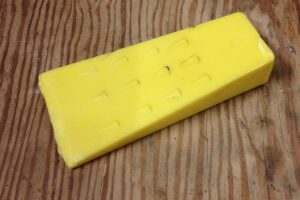
Honey supers are removed. Pry the two brood chambers apart. This may be difficult. One trick being to use a narrow plastic splitting wedge from a chainsaw place. Insert that between the boxes and wedge it in, giving you space to move your hive tool in to separate individual waxed or propolised frames.
It really helps to have a helper on this one. While you lift it off, insert a queen excluder. If not helper endowed, lay it down on some plastic with some spacers so not to crush the bees. You do not want to lose the queen in the grass.
Set the hive back on and put an excluder over this. Replace the honey supers. You will wait five days or a week before coming back.
Removing the top excluder you now examine the top box for evidence of a queen. Only the box with eggs and young larvae will be the one with the queen. This is the one we will leave in the original location.
If that top box has no eggs or young larvae you will remove it. Set to a new location and in the late afternoon or the next day, introduce a new queen.
We know the queen is in the lower box, so we will leave that one alone, perhaps adding another brood box and lifting up the queen excluder.
Leave the nuc for a week but check for eggs and need for more supers at that time.
NOTE: If a lot of queen bees are incoming, I sometimes will be using TWO four frame nuc boxes which will super on top of the existing hive box. Or if you have THREE, you will need to use a wider bottom board to fit the three, drilled like an inner cover to give access to all three boxes. It will overhang the existing lower brood box.
An artificial swarm!
Come May and a good nectar flow many Carnolian hives will be itching to swarm. One answer is to create an artificial swarm. This basically follows the principles in establishing nucs with one variation. You remove the parent colony to a new site and replace it with a fresh empty hive.
- You leave the QUEEN and a couple of frames without queen cells in the original but moved hive.
- You move most of the brood frames into the new empty hive which is in the original location.
- One colony becomes a swarm and has a fertile queen, little brood and worker bees. It begins all over again.
The new colony has no queen, but brood in all stages and most importantly, queen cells ready to go. It too has a reduced worker force as you have moved some bees out with the old queen, but foragers will come back and augment its strength. And so it goes.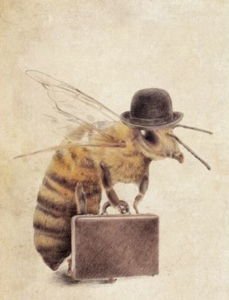

Sometimes splits do not work out and you end up with a queen less hive. Worse yet the worker bees get it into their minds to start laying eggs as the normal restricting pheromone from the queen no longer exists.
I understand the methods to dispose or correct such a hive, but my question is this:
Just how long could such a hive survive, if they are not fed and if the workers begin to lay Drone eggs rather than replacement workers? Six weeks is the normal lifespan of a bee so unless egg laying lengthens it the problem slowly disappears. More to the point, if no normal workers are being hatched and go out to bring nectar and pollen in the drones and these laying workers may die off even sooner.
I will just let it go on as I need those drones and when my purchased queens arrive I will dump these bees some 100 yards from the existing hive. One certainly does not introduce a new queen into a colony that is full of queens in thinking. They will kill her in a heartbeat.
Package vs nuc challenge. EXCELLENT comparison between nuc vs. package outcomes. https://www.youtube.com/watch?v=QsVGdxEE0Vw
Strong nucs/poor packages/fixing foundation
https://www.youtube.com/watch?v=E0TwhZF2Z0Q